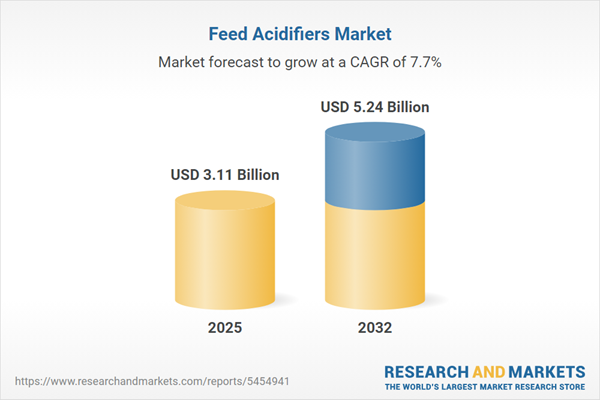Speak directly to the analyst to clarify any post sales queries you may have.
Senior executives navigating the animal nutrition sector must address an evolving landscape shaped by regulatory changes, ongoing sustainability priorities, and a demand for solutions that optimize feed programs globally. Feed acidifiers offer a strategic tool to strengthen livestock health, foster compliance, and advance operational goals throughout diverse supply chains.
Market Snapshot: Feed Acidifiers Market Overview
The global feed acidifiers market is currently valued at USD 2.89 billion for 2024, with projections indicating growth to USD 5.24 billion by 2032, at a compound annual growth rate (CAGR) of 7.73%. Growth within this sector is primarily propelled by efforts to reduce the use of antibiotic growth promoters and by a heightened focus on sustainable sources of animal protein. Feed acidifiers are increasingly embedded in business strategies as companies seek to reinforce the health of their livestock, comply with shifting regulatory standards, and meet expectations for food safety. Organizations enhancing their supply chain agility and adapting regionally are well positioned as adoption of acidifiers expands across animal production systems worldwide.
Scope & Segmentation of the Feed Acidifiers Market
The following segmentation outlines targeted insights and supports the development of agile market strategies for industry stakeholders:
- Acidifier Types: Includes benzoic, formic, lactic, and propionic acids, each playing unique roles in meeting various animal health requirements and nutritional needs.
- Livestock Applications: Solutions specifically formulated for aquaculture, companion animals, poultry, ruminants, and swine optimize efficacy and suitability across major animal production sectors.
- Delivery Forms: Granules, powders, and liquid concentrates accommodate a diverse range of feed manufacturing practices and enable seamless integration on farms or in industrial operations.
- Feed Integration: Products incorporated into compound feeds, specialty blends, and premixes offer scalable options for businesses from small-scale farms to global enterprises.
- Distribution Channels: Established dealership networks, direct sales, and digital procurement platforms provide access to products, reflecting the rising influence of technology in agricultural sourcing models.
- Regional Presence: The market operates in the Americas, Europe, Middle East, Africa, and Asia-Pacific, adapting to varied regulatory requirements, supply infrastructure, and customer preferences to support broad expansion.
- Industry Leaders: Leading companies such as BASF SE, Evonik Industries AG, ADISSEO France SAS, Koninklijke DSM N.V., Kemin Industries Inc., Novus International Inc., Perstorp Holding AB, Corbion N.V., Anhui Tanke Bioscience Co., Ltd., and Calpis Co., Ltd. drive innovation and establish benchmarks across the sector.
Key Takeaways and Strategic Insights
- Feed acidifiers enable organizations to align with worldwide movements to reduce antibiotic usage in livestock and encourage more responsible animal care practices.
- Developments in encapsulation and delivery technologies enhance product stability and nutrient utilization, leading to more consistent feed outcomes across diverse agricultural operations.
- Integrated approaches that combine acidifiers with functional additives like probiotics and botanicals are emerging, supporting compliance with more stringent animal welfare and production guidelines.
- Continuous product innovation and the ability to tailor solutions to different regional demands help companies maintain competitive positioning in dynamic markets.
- Digital management platforms in animal nutrition empower precision tracking and optimized decision-making by providing analytics at the species and farm levels.
- Heightened requirements for transparency and supply chain traceability are accelerating the adoption of feed acidifiers, giving producers enhanced visibility and risk mitigation capabilities.
Tariff Impact
Recent U.S. tariff changes have encouraged producers in the feed acidifiers market to broaden their sourcing channels and strengthen regional supplier relationships. These efforts contribute to continued supply chain stability and protect operations against evolving global trade conditions.
Methodology & Data Sources
This report draws from a rigorous mix of secondary research, regulatory analysis, and structured interviews with sector experts. Robust data triangulation and validation ensure comprehensive and balanced market insights to inform executive decision-making.
Why This Report Matters
- Enables senior management to anticipate market changes and design agile strategies as regulatory and sustainability expectations evolve.
- Guides the integration of feed acidifiers and best-practice management into operations, supporting improvements in efficiency, productivity, and compliance throughout the animal nutrition supply chain.
- Delivers actionable regional intelligence to support market entry planning, bolster supply networks, and enhance global competitiveness in animal protein production.
Conclusion
This research provides senior leaders with actionable intelligence to optimize feed strategies, proactively manage supply risks, and support the advancement of responsible practices in animal agriculture.
Additional Product Information:
- Purchase of this report includes 1 year online access with quarterly updates.
- This report can be updated on request. Please contact our Customer Experience team using the Ask a Question widget on our website.
Table of Contents
3. Executive Summary
4. Market Overview
7. Cumulative Impact of Artificial Intelligence 2025
Companies Mentioned
The companies profiled in this Feed Acidifiers market report include:- BASF SE
- Evonik Industries AG
- ADISSEO France SAS
- Koninklijke DSM N.V.
- Kemin Industries, Inc.
- Novus International, Inc.
- Perstorp Holding AB
- Corbion N.V.
- Anhui Tanke Bioscience Co., Ltd.
- Calpis Co., Ltd.
Table Information
| Report Attribute | Details |
|---|---|
| No. of Pages | 191 |
| Published | November 2025 |
| Forecast Period | 2025 - 2032 |
| Estimated Market Value ( USD | $ 3.11 Billion |
| Forecasted Market Value ( USD | $ 5.24 Billion |
| Compound Annual Growth Rate | 7.7% |
| Regions Covered | Global |
| No. of Companies Mentioned | 11 |









